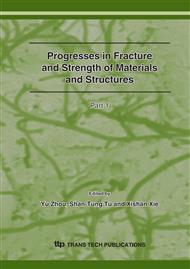p.385
p.389
p.392
p.396
p.400
p.404
p.408
p.412
p.416
Influence of Residual Stresses on the Interfacial Toughness Measurement by Cross-Sectional Nanoindentation
Abstract:
Cross-sectional nanoindentation (CSN) is a new method for measuring interface adhesion of thin films. The interfacial energy release rate (G), characterizing interfacial adhesion, is calculated from the material and geometrical parameters relevant to the test. Effects of residual stresses on G and crack tip phase angle Ψ, have been studied by finite element simulation in this study. The results show tensile residual stresses increase G and compressive stresses reduce it, and they have similar effects on the magnitude of Ψ.
Info:
Periodical:
Pages:
400-403
Citation:
Online since:
September 2007
Authors:
Price:
Сopyright:
© 2007 Trans Tech Publications Ltd. All Rights Reserved
Share:
Citation:


